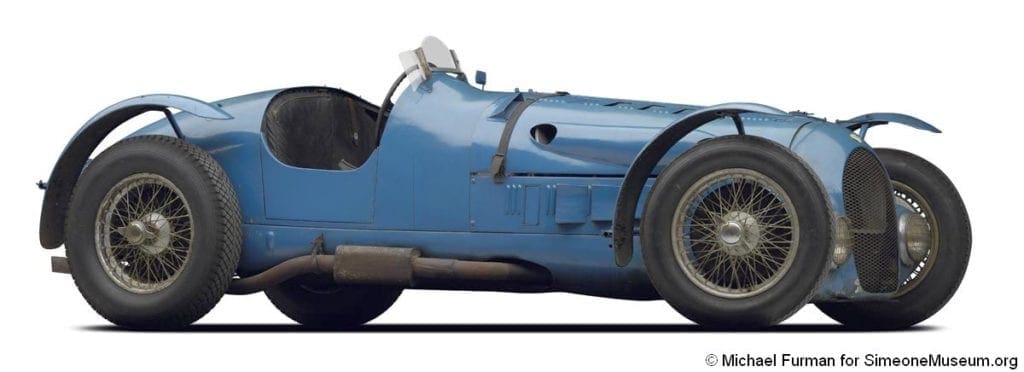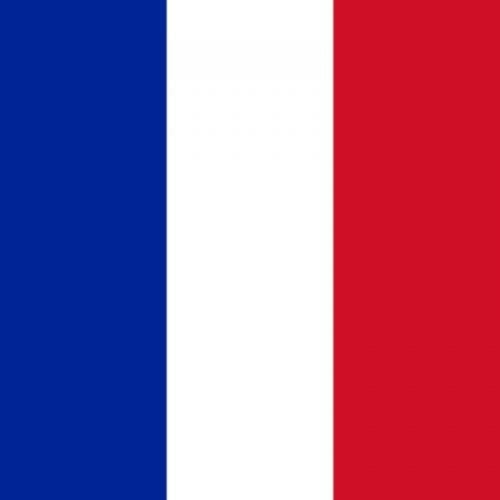This car raced at Le Mans 4 times in its remarkable 15-year competition life. It is in original, unrestored condition.
THESE CARS
Nineteen thirty-six was a turbulent time for racing in France. They had cancelled the Le Mans because of social unrest and strikes. Delahaye road cars had success in rallies and long-distance races the year before, such as a fifth at Le Mans and a third at the Targa Abruzzo race. The management decided to emphasize sports car racing.
They designed the new Type 135 sports car with a 3,557-cc engine using technology of the Delage Company that Delahaye just acquired. That year they turned out 14 lightened, lowered, powerful competition sports racing cars. They had triple-Solex side-draft carburetors, magneto ignition, pretty curves, and they would generate 140 horsepower at 4,200 rpm. They boasted success in smaller races, such as Algiers, where they took the first four places against strong competition and the outright win against the big guns in the 24-hour Belgian race. In the French Grand Prix one placed second to our Tank. The drivers often preferred the Cotal preselector magnetic gearbox, with four solenoids acting as clutches for the four speeds.
In subsequent years they won the Monte Carlo Rally, the Rainier Cup sports car race at Monaco, Donnington, Antwerp, and in 1938, the Le Mans 24 Hours. A Delahaye 135 even beat our Alfa Romeo 8C 2900B Mille Miglia Spyder in the famous “world’s fastest road car” battle at Brooklands in 1939, though the Alfa had a simple gear selector problem which put it hors de combat.
The car has been often maligned because of its overhead valve/pushrod engine with its four-bearing crankshaft. Its 150 horsepower on hand seemed somewhat anemic. What is most important, however, is that these cars were reliable! They finished the races. The fussier, higher-rpm, higher-horsepower competitors often failed. This engine, often described by the British motoring press pejoratively as “industrial”, usually survived. After World War II a few of these original racers such as the one in our collection were revitalized, re-bodied and continued to carry the French flag.
OUR CAR
This was one of the fourteen Delahaye 135S sports race cars made by the factory in 1936 and sold to various drivers. They were the last ever made. Our car was purchased by Pierre Louis Dreyfus ( whose sobriquet was Heldé). They built it in the first quarter of 1936 and Heldé planned to race it in the 24 hours of Le Mans that year, but they canceled the race because of social unrest. He entered it in the Grand Prix de la Automobile Club de France on June 28, 1936, and the Grand Prix de la Marne on July 5. They later sold the car to Count Francios de Bremont.He raced it at the Grand Prix de Pau, where it did not finish and it came in sixth in the Grand Prix of Tunisia.
He also entered it at the three-hour Marseille race on June 6th of that year. In early 1938, it sold again, this time to Madam Germaine Rouault, where she registered it in Paris. Her friend, Louis Gerard, entered it in the British coronation Trophy in April and the Junior 200 mile race in May of that year. Subsequently, Gerard decided to re-body his beautiful Figoni Delage D6-70 Coupe, which came in fourth at Le Mans in 1937. They gave the Figoni body to Madame Rouault who placed it on this Delahaye race car. She entered various races in 1938 and ’39, and she was first in the La Turbie hill climb portion of the 1939 Paris-Nice Rally. When she semi-retired, she sold the car to Eugene Chaboud who re-bodied it after World War II and entered it in 30 races between 1945 and 1948.
His greatest success was winning the Grand Prix of Belgium, but he had other podium finishes. In 1947, the car placed eighth at Monza and second at the Grand Prix, Turin. In 1947, he was declared “Champion de France” because of his racing record with this car. In 1948, Chaboud and his friend Charles Pozzi (later to become the Ferrari importer for France), joined to form the racing team Ecurie Lutetia, and they had both of their cars re-bodied by Valtat on similar lines. This is the body currently on the car and has its original paint and upholstery undisturbed. Delahaye loaned them two type 175S engines, which had 4.5 liter, six-cylinder units capable of delivering around 200 horsepower.
Chaboud had this car modified by the factory to include V12 front suspension reaction arms, cross members, and rear axle to handle the additional weight of the larger engine. They entered the car in Le Mans on June 25, 1949, driven by Chaboud and Pozzi, but it retired. On August 7th, at the Grand Prix of the Automobile Club of France, the car had to retire, but the sister car of Pozzi is the outright winner. Both cars were in for the 1950 Le Mans, but they did not finish. The last major race for 47192 was the 24 hours of Le Mans in 1951.
Because of previous difficulties with the larger engine or because Delahaye wished a return of their 145 engines, they installed the original 135S engine into the chassis for the 1951 Le Mans race. This engine appears, based on external dating characteristics, to be the same race engine removed prior to the insertion of the 145 engine. The car was unsuccessful in that race and remained dormant for seven years until they sold it to Carlos Ankersmit in 1958. He used it little and parked it in his garage in 1969 where again it reposed for 20 years. He sold the car at auction on April 29, 1989.
We gained it in trade for a Vauxhall 30/98 and cash via Danny Margulies, it was essentially in an unaltered condition in every respect. The paint was original with some touch up on the fender edges. The racing engine was intact with three side draft Solex carburetors and the overall external and internal appearance seemed a match to many contemporary photographs. Our thanks go to Andre Vancourt who is the keeper of the Delahaye archives and he is meticulously cognizant of the racing history of the great Delahaye automobiles. The extensive research he did decoded the alterations, made when the factory 175 engine was re-installed and the addition of components from the V12 chassis. He was helped by Pierre Abeillion with his research.















